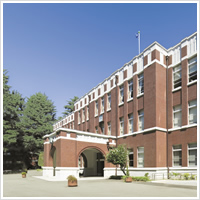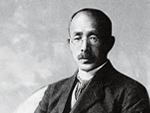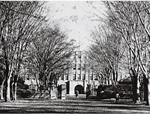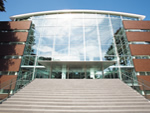Founding Spirit and Educational Goals

Instead of an over intellectual approach, Seikei University is committed to realize a well-balanced education of the heart, mind and body, and has inherited the educational principles of the founder Haruji Nakamura, who practiced "human education of the character and respect for the individual." These are the educational policies of an old-education-system high school, the predecessor of the university, and include development of character, the focusing on experience, a respect for science, and the cultivation of internationalism, and in addition its liberal academic culture carefully nurtures each student's unique personality, while valuing close relationships and interactions between teachers and students through education in small classes.
Our society, which has developed with a focus on material wealth, will enter into a period of maturity. The world will become more borderless and ever more complicated. These times require an attitude of having your own inner principles, flexibly adapting to different values, and actively addressing challenges in cooperation with other people.
In Seikei University, we have set educational goals to nurture the following four attributes, which we believe will best fit our students for the age of globalization in the 21st century.
-
1
- Develop abilities to find and solve tasks and to explore the essence of things with wide-ranging education and deep specialized knowledge.
-
2
- Develop true global skills to accommodate various cultures, environments, and situations and to cooperate with others.
-
3
- Develop self-motivation and positive attitudes to actively tackle the unknown and to learn for life.
-
4
- Develop individuality and abilities to express ideas and opinions correctly and clearly.
To improve the above four goals, we have incorporated five features to encourage opportunities for gaining experience while connecting with many "outside" worlds including foreign countries, societies and regions outside the university, and people from other generations into our education programs.
Characteristics of Seikei University Education - The Seikei Method (5 Pillars)
| 1. | Seminar-Based Study with Close Relationships between Teachers and Students |
- Face-to-Face Education
The founder of Seikei Gakuen, Haruji Nakamura, stated that educational achievements can be accomplished by "connecting the true intentions of teachers and of students". Seikei University has carried on this tradition by arranging seminars for all school years, and seminars for the 3rd and 4th years are required in all faculties (at least 8 credits). Teachers and students engage in spirited discussions by sincerely focusing on the essence of learning.
| 2. | Compulsory Systematic Curriculum and Graduation Thesis |
- A Desire to Keep Searching
In order to study, it is necessary to dig deeply into the question "Why". When humans become immersed in something, they tend to forget everything else, even the need to eat. This ability to concentrate is something that supports human progress. At Seikei University, the curriculum is staggered and systemized from introductory guided studies through to advanced courses in order to immerse you in a subject, culminating in the graduation thesis (graduate study and seminar dissertation), which is required by all faculties.
| 3. | Cross-Faculty Education Program with Interdisciplinary Collaboration |
- Creative Integration of Knowledge
By meeting, communicating, and collaborating with advanced intellectuals who are continually pursuing their own specialties, the result is often a dramatic achievement beyond expectation. At Seikei University, all faculties are located on one campus, and this characteristic is utilized to provide education programs such as MBT (Marunouchi Business Training) and the Seikei International Course where students can have cross-faculty interactions and collaborate in order to discover and resolve tasks.
| 4. | A Spirit of Self-Motivation to Tackle the Unknown |
- Encouraging Study Outside the Classroom (Extracurricular Activities) such as Overseas Education, Volunteering, Internships, and Local Exchange
There are countless opportunities for learning outside the classroom. Tackling something unknown based on joy and taking action with the "thrill", not being afraid of new things or trying something different leads to self-growth. In addition, by exposing yourself to outside work, you can contact diverse values and cultivate true cooperation. We at Seikei University encourage and support studying outside the classroom including extracurricular activities, overseas education, volunteering, internships, and local exchange.
| 5. | Genuine Career Education and Thorough Employment Support |
- Earnestly Considering Your Future
People engage in society through their occupation and work. The genuine purpose of career education is to help "students themselves" consider earnestly the shape of future society and their roles to play in it. Because of our traditional linkage with the economy, it has been said that "Seikei’s strong point is employment", and employability remains a characteristic through systematic career education starting from the first year, and by thoroughly and carefully helping earnest students to determine their career decision and employment.
Chronology
| 1906 | A small private school is founded by Haruji Nakamura (1877-1924); named Seikei-en the following year. |  |
|---|---|---|
| 1912 | Seikei Jitsumu Gakko is established in Ikebukuro. | |
| 1914 | Seikei Junior High School is established. | |
| 1915 | Seikei Elementary School is established. | |
| 1917 | Seikei Business School and Seikei Women’s School are established. | |
| 1924 | Relocated from Ikebukuro to Kichijoji. | |
| 1925 | Seikei High School (seven-year program) is established. | |
| 1947 | Seikei Junior High School is re-established under a new system. | |
| 1948 | Seikei High School is re-established under a new system. | |
| 1949 | Seikei University is established with the Faculty of Political Science and Economics. |  |
| 1962 | The Faculty of Engineering is established. | |
| 1965 | The Faculty of Humanities is established. | |
| 1966 | The Graduate School of Engineering is established. | |
| 1968 | The Faculty of Political Science and Economics is reorganized into the Faculty of Economics and the Faculty of Law. | |
| 1970 | The Graduate School of Economics is established. The Graduate School of Law is established; renamed the Graduate School of Law and Political Science in 1972. |
|
| 1971 | The Graduate School of Humanities is established. | |
| 1972 | The Graduate School of Business is established. | |
| 1981 | The Center for Asian and Pacific Studies is established. | |
| 1993 | The Center of International Exchange is established. | |
| 1998 | International House is opened. | |
| 2004 | The Graduate School of Legal Apprenticeship (Law School) is established. The Center of International Exchange is reorganized into the Seikei Institute for International Studies. |
|
| 2005 | The Faculty of Engineering is reorganized into the Faculty of Science and Technology. | |
| 2006 | The new University Library building is completed. |  |
| 2007 | The Graduate School of Economics and Management is established. | |
| 2009 | The Graduate School of Engineering is reorganized into the Graduate School of Science and Technology. | |
| 2012 | The 100th anniversary of the founding of Seikei Gakuen. |  |
| 2014 | The Seikei University Volunteer Center is established. The Seikei Center for Higher Education Development (SCHED) is established. |
|

